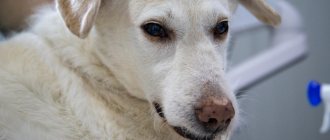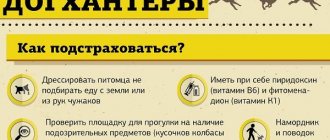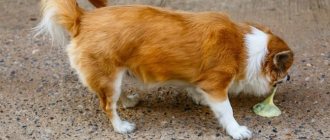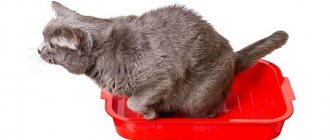Vomiting in dogs can occur for a variety of reasons; not all of them require immediate veterinary attention. Sometimes this act of reflex emptying of the stomach is physiological in nature. For example, this is how puppies burp after overeating milk. Physiological vomiting goes away on its own. Pathological vomiting is a less pleasant phenomenon, indicating problems with the pet’s health, requiring diagnosis and treatment. In our article, we have collected all the information about this unpleasant pathology that dog owners need to know.
Causes of vomiting in dogs
The first thing you need to determine is how vomiting differs from regurgitation (regurgitation).
Regurgitation is the passive process of backflow of undigested food from the esophagus. It occurs once and should not frighten dog owners. This way the animal gets rid of excess food. The mass that the dog regurgitates does not have an unpleasant odor and is covered with mucus.
Vomiting is the process of emptying the stomach and upper intestines. The purpose of such emptying is to get rid of toxic substances, foreign objects, and poisons. Vomit has an unpleasant, pungent odor and can have a different structure.
The reasons for this phenomenon are varied. They can be divided into two large groups. The first category includes those that do not require urgent veterinary intervention. The second includes serious problems that require immediate diagnosis and treatment.
Causes of physiological vomiting
If your pet vomits once and after that he behaves as usual: cheerfully, actively, without loss of appetite, you don’t have to worry. This is a physiological emptying of the stomach.
What can cause physiological vomiting:
- Eating green grass to stimulate gastric emptying.
- Motion sickness while traveling in transport.
- Overheating in a hot, stuffy room.
- Binge eating.
- Reaction to vaccination.
- State after anesthesia.
- Stressful state.
- Physiological gastric emptying in lactating bitches.
- Toxicosis in pregnant dogs.
- A sudden change in diet.
- Long breaks between feedings - hungry vomiting in the morning.
Causes of pathological vomiting
This group of causes causes pathological nausea and vomiting, which indicates serious problems with the pet’s health.
What causes pathological vomiting:
- Diseases of infectious origin: tuberculosis, canine distemper, parvovirus enteritis, leptospirosis, etc.
- Chronic diseases: gastritis, diabetes, stomach ulcers, pancreatitis, cholecystitis, hepatitis, etc.
- Food allergies.
- Oncological diseases.
- Gastrointestinal injuries.
- Worm infestation.
- Chronic renal failure.
- Inhalation of caustic, irritating substances: carbon monoxide, smoke, poisonous insects.
- Poisoning with pesticides, rat poisons, household chemicals, mercury, fluorine and lead compounds.
- Foreign objects entering the dog's gastrointestinal tract.
- Damage to the central nervous system.
- Severe food poisoning with subsequent intoxication.
- Constipation and paralytic ileus.
- Cardiac diseases: heart failure, cardiomyopathy.
- Respiratory diseases: laryngitis, tracheitis, pharyngitis, etc.
- Blockage of the intestines by foreign objects.
Important!
If the dog experiences anxiety before and after the process of vomiting, its stomach growls, diarrhea, coughing, and vomit with foreign impurities appears, the dog should be examined immediately by a veterinarian.
Vomiting up undigested food
On average, the time from food intake to entering the intestines in puppies is from 3 to 5 hours. This figure depends on the type of food.
- Dry food takes longer to digest; on average, the journey to the intestines takes five hours.
- For natural food it’s faster – about three hours.
The final digestion of food takes:
- With natural feeding, six hours.
- When feeding dry food, final digestion takes an average of eight hours.
Reference! You need to understand the difference between vomiting and regurgitation.
- Vomiting is accompanied by strong salivation and has many different causes. When vomiting, the animal most often changes in behavior, and anxiety is noticeable. During this process, the whole body is involved, the puppy may back away and hunch over.
- Regurgitation does not cause much discomfort for the dog. Most often in puppies this is due to overeating.
Types of vomiting
According to the nature of the course of the disease, the pathology is divided into:
- spicy;
- chronic.
Acute - a sudden, rapidly passing, one-time attack. Most often caused by physiological reasons.
Chronic – characterized by a longer period, can be repeated with a certain frequency. Its causes are pathological.
Based on the composition and appearance of vomit, the following are distinguished:
- vomiting with white foam;
- with bile;
- with blood;
- green vomit.
Dog vomiting white foam
A one-time attack that is not accompanied by an increase in body temperature, changes in behavior and loose stools is a physiological process. It does not indicate the presence of pathology in the animal.
Vomiting with white foam occurs in two cases:
- on an empty stomach;
- immediately after eating.
If the dog vomits some time after eating, then at this time the food moves from the stomach into the gastrointestinal tract. The stomach becomes empty and becomes covered with protective mucus, which contains proteins and polysaccharides. During an attack of vomiting, they combine with air and whip into white foam.
White foam can also form if the dog vomits on an empty stomach. This phenomenon indicates minor dysfunction of bile secretion. Bile enters an empty stomach - this provokes an attack. If this situation occurs frequently, you should take your pet to the veterinarian.
Vomiting with bile
Yellow vomit indicates that bile is present in the vomit. This situation develops against the background of dysfunction of the gallbladder or duodenum. Bile enters the stomach, irritating its walls, which causes an attack of vomiting.
Causes of yellow vomit:
- Infectious or viral hepatitis. The dog’s health deteriorates, body temperature rises, appetite and activity decrease, and stool disorders appear.
- Chronic gastritis. Accompanied by weight loss, the appearance of apathy, and the development of anorexia.
- Worm infestation. Develops against the background of severe intoxication. Possible death.
- Piroplasmosis. The disease develops after ixodid tick bites and leads to the death of pets.
- Stomach ulcer – acute stage.
- Benign and malignant tumors of the stomach.
Important!
Bile in vomit is a dangerous symptom. The dog requires urgent assistance from a veterinarian.
Vomiting blood in a dog
The color of bloody vomit varies from pink and red to brown. Sometimes this vomit may have a black tint.
Blood can enter from damaged walls of the stomach or esophagus - injury by a foreign body (bone). From a bleeding stomach or intestinal ulcer. As a result of dysfunction of the liver and kidneys or neoplasms in the gastrointestinal tract. This symptom indicates the development of certain infectious diseases. In this case, vomiting is accompanied by hyperthermia and general weakness of the animal.
Important!
Bloody vomiting is always a dangerous symptom. Regardless of the reason why blood got into the vomit, the dog must be shown to a veterinarian.
Green vomit in a dog
The green color of the vomit indicates that intestinal contents have entered the dog's stomach. This happens if the dog has an intestinal obstruction, severe helminthic infestation, or some kind of infectious disease. All of these conditions are very serious and therefore require immediate attention to a specialist.
Important!
In the summer, the green color of the mucus may indicate that the dog is eating grass - only such green vomit is safe.
According to severity, vomiting is divided into:
- Self-passing. This type does not require treatment and goes away on its own. The only treatment that may be required is diet.
- Easy. There are no life-threatening symptoms and no serious complications. Treated with antiemetics and drinking plenty of fluids.
- Heavy. It is protracted in nature, foreign inclusions (blood, bile) are present in the vomit, and is characterized by serious complications. Possible death.
Vomiting in a pregnant dog
In a pregnant dog, vomiting and nausea are a manifestation of toxicosis. This condition is temporary and is associated with changes in the dog’s body during pregnancy. Most often, toxicosis is observed at 3-4 weeks of pregnancy and in the middle of its second half.
Usually the condition goes away on its own. The owners need to surround the expectant mother with care and attention and protect her from stressful situations. It is not recommended to force feed a pregnant dog if it refuses to eat.
A veterinarian's help may be required in the following cases:
- vomiting continues for more than a week;
- The dog vomits frequently and profusely – more than 3 times a day.
Important!
It is forbidden to overfeed dogs with toxicosis - this worsens their condition.
When to see a doctor
In many cases, vomiting in dogs goes away on its own, without the intervention of a veterinarian, but if certain symptoms appear, it is not safe to delay a visit to the veterinarian.
You should immediately take your pet to a doctor if:
- There is an admixture of blood in the vomit.
- The urge is repeated after a short period of time.
- The animal's urination has become more frequent.
- Yellowing or blanching of the gums and mucous membranes of the eyes is observed.
- Excessive lethargy and weakness.
- Abdominal pain and bloating.
- Prolonged diarrhea or constipation.
- Feverish conditions.
- Cramps.
- Sharp weight loss.
- Complete refusal of food and water.
If you provide your pet with quality veterinary care in a timely manner, you can save the dog’s life, but unfortunately, most owners prefer to wait until the vomiting goes away on its own or try to help their pet using folk methods. Any self-medication is extremely dangerous for the dog’s health and can only hasten tragic consequences.
Treatment of vomiting in dogs. What to do
A treatment plan is developed by a veterinarian after an accurate diagnosis is made. It is not the vomiting itself that is treated, but the cause that caused it.
Why is vomiting dangerous?
Long-term vomiting, accompanied by loss of appetite and diarrhea, leads to dehydration. Vomiting in a puppy is especially dangerous - without veterinary care, the baby can die in less than a day.
How to help your dog before visiting the veterinarian
Until the diagnosis is established, the owner can help his pet by following these simple rules:
- Don't panic, try to determine the nature of the nausea.
- Try to calm your dog down and never scold him for vomiting.
- There is no need to try to stop the process yourself.
- Try to determine the cause - this will help the doctor make a diagnosis.
- Record the amount of retching, associated symptoms, and type of vomit.
- As soon as your dog vomits, stop feeding him.
- Instead of water, let your dog lick ice cubes.
If there are accompanying symptoms (fever, diarrhea), a sharp deterioration in the pet’s condition and an alarming composition of the vomit (blood, bile), immediately show the dog to a doctor.
Diagnostic measures
The following tests may be ordered for your dog at the clinic:
- taking anamnesis;
- external examination of the dog;
- Analysis of urine;
- Ultrasound of the abdominal cavity;
- radiography;
- blood analysis;
- biopsy;
- endoscopic studies.
Only after assessing the results of all tests is treatment prescribed.
The treatment regimen necessarily includes therapeutic fasting, medication procedures and measures to adjust the diet.
Drug therapy
Vomiting is a symptom, not a disease. Drug therapy is prescribed after assessing the clinical picture and establishing the main diagnosis that provoked the attacks:
- If helminths are found in the dog - Drontal Plus, Milbemax, Polyvercan, Prazicide.
- Infectious diseases are treated with antibiotic therapy.
- To relieve pain, antispasmodics are used: Drotaverine or Papaverine.
- The level of acidity in the stomach is reduced by Omez.
- To eliminate symptoms of dehydration, droppers with saline, glucose and Ringer-Locke infusion solution are used.
- Intoxication syndrome is relieved with absorbent drugs: activated carbon, Polysorb, Enterosgel.
- To strengthen the immune system, immunomodulators are used: Katozol, Ribotan, Gamavit, Maksidin.
- For the treatment of chronic diseases of internal organs, specific therapy is prescribed.
Drug treatment is accompanied by a “gentle” diet.
Feed selection
Inexperienced dog breeders need to know that the dog should absolutely not be fed from the table . If the animal does not eat sausage, fried or smoked, this will help prevent vomiting.
Also, many owners often give their pets bones. This also cannot be done. Chicken ones are especially dangerous - they are hollow inside and, when chewed, break into sharp fragments. This can severely damage the stomach wall.
Proper feeding from one month of age
With dry food everything is simple, you select it according to age and breed.
Important! If you adopted a puppy a little older than a month, the food should be soaked at first.
If you feed your pet natural food, then you need to remember a few rules:
- The diet should include grains and make up 25 percent of the daily value.
- Vitamins, also 25 percent. You can use fish oil, bone meal, nutritional yeast, ascorbic acid, some vegetables and fruits.
- Meat - chicken, turkey, beef and lean pork. It is better to give it boiled or chop it finely and pour boiling water over it.
- Meat soup products.
- Fish, preferably oceanic.
- Dairy products. Not recommended in combination with meat products.
Anti-vomiting medications for dogs
The following antiemetic medications are used to stop persistent gagging and prevent nausea in dogs:
- Cerucal.
- Serenia.
- Reisfit.
Cerucal
An antiemetic drug approved for use without a prescription or prescription from a veterinarian. The medicine is based on the active ingredient metoclopramide. Available in ampoules and tablets. Recommended dosage: 0.5-07 mg per 10 kg of live weight 2-3 times a day. Course of treatment: from 5 to 7 days. Maximum daily dose: from 1 to 2 mg per 10 kg of weight.
The drug is prescribed for gastritis, gastrointestinal disorders, heartburn, impaired intestinal motility, pathological hiccups, head injuries, and vomiting.
Contraindication: intestinal obstruction.
Serenia
A new generation veterinary drug made in America. Has high proven effectiveness. The action is due to the maropitant citrate included in its composition, which directly affects the central nervous system (suppresses the gag reflex). The medicine is characterized by low toxicity and safety. It has two forms of release: solution for intramuscular injection and tablets.
Can be used for prevention and as a therapeutic agent. Relieves nausea after anesthesia, prevents motion sickness in transport, and is used in the treatment of cancer. Recommended dosage: 1-2 mg per 1 kg of dog weight per day. The course of treatment is up to 5 days. To prevent motion sickness in transport, give a single dose of 8 mg per 1 kg.
Reisfit
A highly effective medicine based on cyclizine hydrochloride is used to prevent seasickness and motion sickness on airplanes and in vehicles. The optimal effect occurs when taken half an hour before travel. Repeated use is possible after 6 hours. Recommended dosage: 4 mg per 1 kg of weight.
Contraindication: weight up to 2.5 kg.
Age characteristics
Puppies are more susceptible to vomiting undigested food. This is due, as already listed above, to high mobility, improper eating habits, and worms, which cause more obvious symptoms in children than in adult dogs.
Also, at an early age, a dog may swallow a foreign object, such as a piece of a toy, which can lead to vomiting.
What to feed your dog
The first rule is that the dog is not given food for the first 12 hours after vomiting . Therapeutic fasting will allow the dog’s stomach to rest and recover, and the body to cleanse itself. At the same time, you need to offer your dog fresh water (preferably filtered) - 2 teaspoons per 1 kg of weight. In order to restore the salt balance in the body and prevent dehydration, Regidron is prescribed in the dosage indicated on the package.
Subsequently, a special diet is prescribed for therapeutic purposes and for prevention.
Dry food
For therapeutic and restorative purposes, dogs are prescribed special dietary foods:
- Hill's Prescription Diet I/D Canine Gastrointestinal Health dry
- Flatazor Protect Obesite;
- Advance Veterinary Diets Gastroenteric Low Fat Canine Formula;
- Pro Plan Veterinary Diets Canine EN Gastrointestinal dry;
- Happy Dog VET Diet Renal;
- Farmina Vet Life Canine Gastrointestinal;
- Royal Canin Gastro Intestinal Low Fat.
They switch to regular food gradually adding it to the dietary food. At the first feeding the proportion should be 1:1. Then, if vomiting does not recur, you can mix 3/4 regular food and 1/4 dietary food. If the dog tolerates the food well, after 3 days you can return to the normal diet.
Natural food
Naturally fed dogs are switched to light food. After “therapeutic hunger,” the dog is offered 2-3 teaspoons of low-fat, easily digestible food.
It could be:
- skim cheese;
- curdled milk;
- boiled rice;
- steamed beef meatball;
- boiled potatoes;
- oatmeal;
- boiled chicken breast without skin.
You need to feed little by little, but often, offering the dog food every 1-2 hours. For feeding, carbohydrates and proteins are mixed in equal proportions. All food should be without salt and seasonings. The transition to a normal diet is allowed only after 3-4 days.
Important!
If the diet does not help, or your dog continues to vomit, contact your veterinarian immediately.
Puppy keeps vomiting
If you notice your puppy shaking, drooling, having trouble breathing, or having blood in his vomit or blood in his stool, contact your veterinarian immediately as this could be a sign of an underlying problem. Puppies are quite hardy, but they often require more attention and care. If you think your puppy may be in distress or that he may be suffering from dehydration through vomiting, it's time to see a professional. Remember, if you are unsure, it is always advisable to contact your veterinarian. After all, our pets can't tell us what's wrong!











